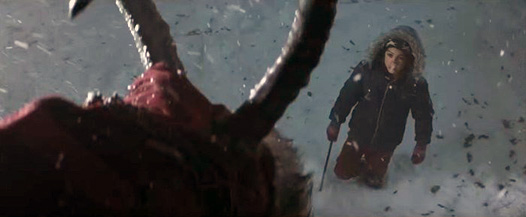|
|
Movie Review: KrampusBy Ben GruchowDecember 16, 2015
Dougherty clearly loves working in this kind of sphere, both horrific and irreverent, and there are moments when Krampus leaps into deranged life. The initial stages of the blizzard, when nobody really knows yet what’s going on, have a nicely claustrophobic tone and feel to them. The initial staging of a seemingly innocuous Jack-in-the-Box has a gruesome payoff later on. There is a sequence involving tiny sentient gingerbread men that strikes the perfect balance between tension and comedy. And there is an animated flashback interlude that for once explains the background of the antagonist without sacrificing the unsettling nature of it (it’s a gorgeous piece of work, too, easily as evocative as the similar sequence in Harry Potter and the Deathly Hallows, Part 1). The movie’s just not that good, is the thing. Not as a whole, at any rate. Those moments are just that, and the tics that work to the advantage of an anthology film show their seams when applied to a feature-length continuous narrative. There are character beats and shadings and subtleties that are set up, and I appreciated them, but there’s no room for any type of payoff. This isn’t meant to be a suspenseful and cathartic treatise about a fractured family coming together in the face of horror; it’s a 90-minute version of those short fables where everyone learns their lesson at the end, except nobody’s really likable here. I can commend the movie for its playfulness, but it doesn’t leave a whole lot to latch onto at the end. And for all of the gruesome visuals and inventive design (when Krampus finally does show himself, he’s legitimately pretty unsettling - and since the movie beforehand hasn’t ever been particularly scary, you can’t apply the adage of the monster’s appearance neutering the horror), the movie is never really scary. Most of the would-be suspenseful sequences are set up for a dark-humor gag, and while that’s fun, it’s also a lark. It only plays well so many times. Trophy winner among its meager kin or not, Krampus isn’t the type of movie that’s going to engender many converts; it’s made by and for those who want to go to a theater and see traditional holiday practices and locations subverted and refocused through the lens of goofy horror, rather than drama or comedy. It’s still impressive and heartening that Universal keeps giving riskier, more experimental horror projects like this adequate budgets and wide releases. They did it earlier this year with The Visit and Crimson Peak, and several years ago with Slither, Drag Me to Hell, and Coraline. There’s something to be said for that kind of investment, even if the resulting film ends up being rather problematic and disjointed.
|

|
|
|

|
Thursday, October 31, 2024
© 2024 Box Office Prophets, a division of One Of Us, Inc.


